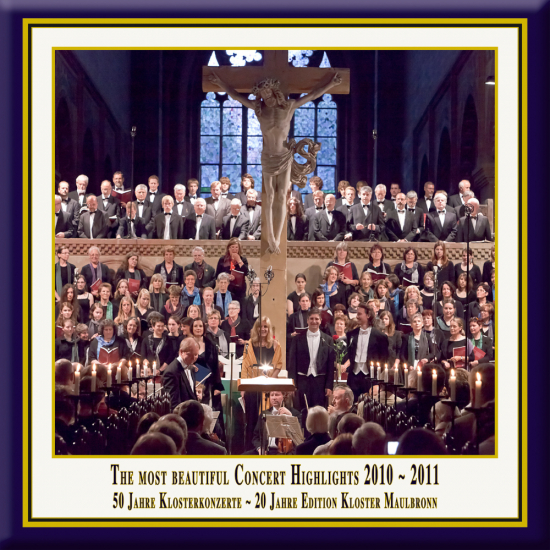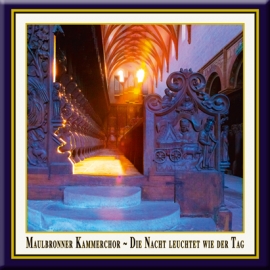Vol. 12: The most beautiful Concert Highlights 2010-2011
The most beautiful Concert Highlights
from Maulbronn Monastery 2010-2011
The 50th Anniversary of the Maulbronn Monastery Concerts
Anniversary Series, Vol. 12
Highlights from
Spohr: The Last Judgement, WoO 61
(June 12 & 13, 2010)
The concert "The Period of Time" (June 20, 2010):
Schop: O Ewigkeit, du Donnerwort & Lachrimae Pavaen
Telemann: Viola da Gamba Sonata, TWV 41:G6 & Die Zeit, TWV 20:23
Carl Philipp Emanuel Bach: Am neuen Jahre: Er ruft der Sonn und schafft den Mond
The Choral Concert "The Night shines as the Day" (July 3, 2010):
Whitacre: Sleep · Brahms: Guten Abend, gut Nacht (Wiegenlied, Op. 49 No. 4)
The Concert "Concert for Strings, Flute & English Horn" (July 9, 2010):
Tchaikovsky: Souvenir de Florence, Op. 70 · Stephenson: Concerto for Cor Anglais & String Orchestra
The Piano Recital "Grand Piano Masters ~ Dreamscenes" (June 4, 2011):
Schumann: Fantasy Pieces for Piano, Op. 12 · Brahms: Piano Sonata No. 3 in F Minor, Op. 5
Brahms: A German Requiem, Op. 45 ("London Version")
(October 1 & 2, 2011)
Live recordings from the German UNESCO World Heritage Site Maulbronn Monastery
HD Recordings · DDD · Duration: c. 129 Minutes
Digital Album · 24 Tracks · incl. Digital Booklet


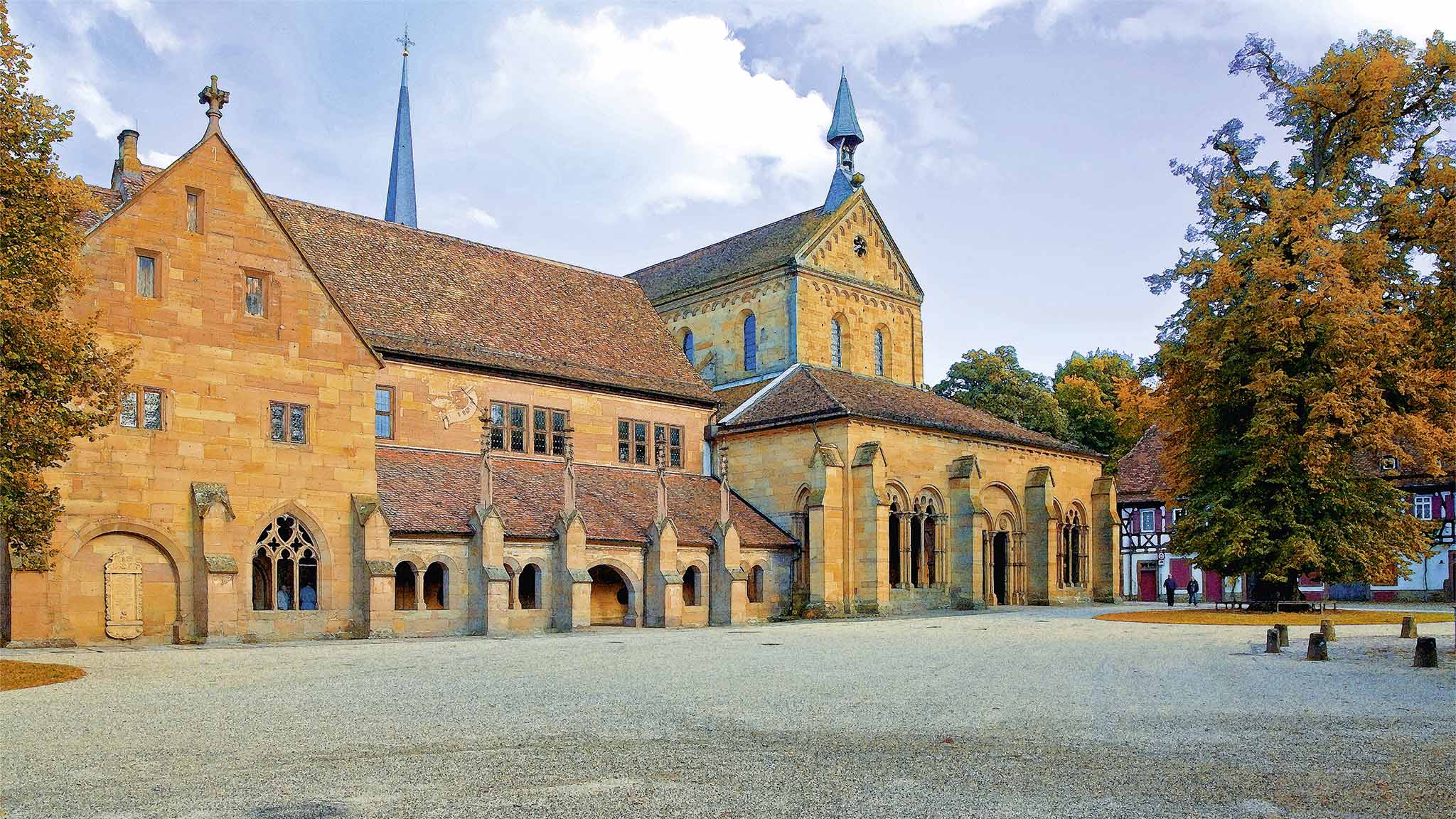
W
e have been documenting for 20 years the concerts at the UNESCO World Heritage Maulbronn Monastery. The concerts supply the ideal conditions for our aspirations. It is, above all, the atmosphere of the romantic, candle-lit arches, the magic of the monastery in its unadulterated sublime presence and tranquillity that impresses itself upon the performers and audience of these concerts. Renowned soloists and ensembles from the international arena repeatedly welcome the opportunity to appear here - enjoying the unparalleled acoustic and architectural beauty of this World Heritage Site, providing exquisite performances of secular and sacred music, documented by us in our Maulbronn Monastery Edition.
Josef-Stefan Kindler & Andreas Otto Grimminger, K&K Verlagsanstalt
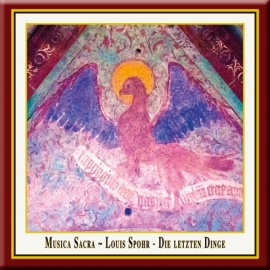
The Last Judgement, WoO 61, by Louis Spohr (1784-1859)
During his lifetime, Louis Spohr, born on April 5th 1784 in Braunschweig (Germany), was named as one of the greatest violinists beside Niccolò Paganini. Unlike many of his contemporaries, whose works are celebrated today, Louis Spohr was already famous during his lifetime and he was considered as one of the great artists of his era, as a musician and conductor and, in fact, as a composer. His rich oeuvre includes more than 200 works, including chamber music, concertos, symphonies, several operas and four oratorios. "The Last Judgement" (in German: Die letzten Dinge) was Louis Spohr's second oratorio and one of his most famous compositions these times. A contemporary reviewer discribed the oratorio as "one of the greatest musical creations of the age." "The Last Judgement" is originated in Kassel between 1825 and 1826, where Spohr has appointed as Music Director after a successful artist career. Spohr himself wrote about the successful premiere, which took place in Kassel on Holy Friday 1826 in a darkened choir under a cross, illuminated by 600-glass lamps: "I must say to myself - the effect was extraordinary! Before that I never had those emotion of satisfaction during the performance of one of my larger works!". Although this oratorio isn't well known today, the sucess of "The Last Judgement" is documented with numerous other performances during the first half of the 19th century. The libretto for "The Last Judgement" is written by the dramatist and music writer Johann Friedrich Rochlitz (1769-1842). The oratorio describes in two parts the scares of the Apocalypse and of the Last Judgement ("Babylon the great is fallen"), based on the Book of Revelation from the New Testament. At the end of the fight between God and the Devil a new heaven and a new earth replace the old. A new "city" is born: the New Jerusalem.
"The Period of Time" ~ Songs, Arias and instrumental Music from the 17th and 18th Century
The philosophical thoughts about hope and future, the waiting and the transiency and about the terrifying idea of eternity in the works of northern and central German composers of the 17th and 18th century. (Central Idea: Simone Eckert)
A Choral Concert, performed by the Maulbronn Chamber Choir, with works by Jacobus Handl-Gallus, Leonhard Lechner, Jan Pieterszon Sweelinck, Moritz Hauptmann, Felix Mendelssohn, Otto Nicolai, Johannes Brahms, Knut Nysted, Sven David Sandström, Wolfram Buchenberg & Eric Whitacre.
Souvenir de Florence for String Orchestra, Op. 70, by Pyotr Ilyich Tchaikovsky (1840-1893)
Pyotr Ilyich Tchaikovsky (1840-1893) is considered as the most important Russian composer of the 19th century. He composed "Souvenir de Florence" in 1890, thus during his later period, and dedicated the work to the St. Petersburg Chamber Music Society in response to his appointment as an Honorary Member. 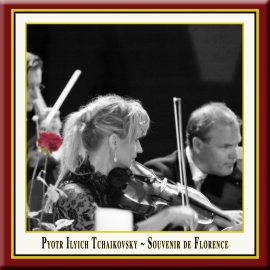 Originally scored for string sextet (2 violins, 2 violas and 2 cellos), Tchaikovsky arranged the work later also for string orchestra. The title "Memory of Florence" probably originates from the fact that the composer started working on it while visiting Florence in Italy.
Originally scored for string sextet (2 violins, 2 violas and 2 cellos), Tchaikovsky arranged the work later also for string orchestra. The title "Memory of Florence" probably originates from the fact that the composer started working on it while visiting Florence in Italy.
The Concerto for Cor Anglais & String Orchestra by Allan Stephenson (born 1949)
Prooving that contemporary works aren't bound to be dissonant is the "Concerto for English horn and string orchestra" by the English cellist, conductor and composer Allan Stephenson. Born in 1949 near Liverpool, England, he studied first cello in Manchester, then moved to Cape Town (South Africa) in 1973. Besides his career as musician and conductor (over the years, he conducted all major symphony orchestras of South Africa) he wrote three operas, symphonic music and concertos for almost all orchestral instruments. Stylistically, his compositions are Late English Romantic school, whereat Modern rhythms and harmonies too take place in his music. Stephenson's credo, music to be due to entertain or please the audience, becomes evident at all times. The "Concert for Engish horn and string orchestra" includes three movements: a slowly introducting first movement, a traditionally sounding, intimate and highly Romantic second movement and a fast finale. The music, being composed in the style of Late English Romantic, allows consistently associations towards film scores. You hear the world premiere of this work from July 9th 2010 at the minster of Maulbronn.
Grand Piano Masters ~ Dreamscenes
"Through evening's shade, the pale moon gleams - While rapt in love's ecstatic dreams - Two hearts are fondly beating", quoted Johannes Brahms above the notes for the "Andante" in the Piano Sonata No.3. This excerpt of a poem by C.O. Sternau (a pseudonym of Otto Inkermann) characterizes the mood of this piece, which had a large contribution to the fame of the young composer. Written in 1853 this "poetic" sonata marks the end of a cycle of three sonatas. Likewise it was the last tune the 20-year-old composer submitted to Robert Schumann for commentary. Robert Schumann himself described Brahms in an article titled "Neue Bahnen" (New Paths) in October 1853 as "a man with a calling" who was "destined to give ideal expression to the times". Accordingly Magdalena Müllerperth has prepended of the Brahms-Sonata, which filled the second part of her recital in the lay refectory of Maulbronn monastery on June 4th 2011, a creation of significance for the compositions of the romantic era: the cycle "Fantasy Pieces" for Piano Opus 12 by Robert Schumann. Inspired by a collection of novellas by E.T.A. Hoffmann, called "Fantasiestücke in Callots Manier", it seems that Schumann had the characters "Florestan" and "Eusebius" in mind - two characters he created for representing the duality of his personality: Eusebius depicts the dreamer and Florestan represents Schumann's passionate side. The virtual dialogue between both characters during the movements ends in the piece "End of the Song", which Schumann has described in a letter to his wife Clara: "Well in the end it all resolves itself into a wedding...". Before these literary-inspired compositions full of poetic pictures and dream scenes by Schumann and Brahms, Magdalena Müllerperth introduced the concert with five dances by one of her personally favourite composers Frédéric Chopin, in continuation to her first published recital which included Chopin's "Impromptus No.I-III" and the "Fantaisie-Impromptu" Op.66 (released as a part of the CD "Comme un jeux d'eau", No.: KuK 16). Chopin's "Mazurkas" - he wrote at least 69 Mazurkas - are based on a traditional Polish folk dance in triple meter with an accent on the third or on the second beat, called "Mazurek". Chopin started composing his mazurkas in 1825, and continued composing them until 1849, the year of his death. With "Dreamscenes" you listen to Magdalena Müllerperth's second piano recital, which is documented on disc.
A German Requiem, Op. 45, by Johannes Brahms (1833-1897)
On Good Friday, April the 10th, 1868, the world premiere of the Requiem in a six movements version was given in Bremen, Germany. Brahms himself conducted the Choral Society of Bremen, having carefully been prepared by Karl Martin Reinthaler to perfom the new release. Friends of Brahms from all over Germany were attending this occasion. Clara Schumann noted in her diary: '... This requiem deeply moved me like no other sacred music... As I saw Johannes standing there with the baton in his hand, I always had to think of my dear Robert's prophecy - let him just take the magic wand, and let him operate with an orchestra and a choir - that is fulfilling today. The baton really transformed into a magic wand and vanquished Everybody, even his most determined enemies. This was such blissfulness for me, I haven't felt so delighted in years. After the performance was a supper at the Rathskeller, where everybody jubliated - it was a celebration of music.' After the performance in Bremen, Brahms returned to Hamburg, where he finished the work by the addition of the movement. 'You now have sadness' that was finished in the autograph of the particell with 'Hamburg May 68'. In 1869 eventually, the complete opus was performed at the 18th of February in Leipzig under the direction of Karl Reinecke. Eduard Bernsdorf, the critic of the journal 'Signals of the musical world', who ten years earlier had called the piano concerto in d-minor a piece of 'bleakly waste and drought', nowhad no choice but to acknowledge in his critique on February the 22th, 1869: '... you so have to number the questionable work of Brahms among the most important doings having been accomplished by our younger and youngest generation of composers, as well as you have to designate it the most important of the Brahmsian creations. Above all, an aspiration for the Grand and Noble does announce itself here and, coherring, the complete negation of the Ordinary and Banal...' Johannes Brahms himself produced a four-handed version of his German Requiem for piano that was publicized first in London in 1871. The publication of simplified musical versions for piano duo was common in the 19th century, being in some respects the precursor of acoustical recording because it allowed musical amateurs to experience great works outside the concert hall by their own performance on the piano. Brahms worked on this version himself, i.a. out of the conviction that if it really had to happen, he would be the best candidate for this duty. All in all, he considered this work as unworthy, but necessary, thus he refused noting his name as arranger on the front page, and as it happened anyhow, he ordered the exemples already printed to be recollected and added with new front pages not naming him as arranger any longer. In a letter Brahms stated ironically: 'I dedicated myself to the noble occupation of rendering my immortal creation enjoyable also for the four-handed soul. Now it can't decline.'. Even if it obviously didn't answered the Maestro's basic idea, the piano version gives considerably more room for dynamics and therefore serves the tension of the work. Prior condition is a choir and a conductor that see an opportunity and even are challengend by the minimalism of the instrumentation in filling these deep moments with all the tension human voice is capable of. The vocal performance is enriched by the convertion of the piano version by Brahms himself, because he in person decided on the atmospheric form of his presentation. It is quite exciting to hear the chamber choir merge into word and work and having the courage of dedicating itself to the Requiem's spirit.
P
ublishing Authentic Classical Concerts entails for us capturing and recording outstanding performances and concerts for posterity. The performers, audience, opus and room enter into an intimate dialogue that in its form and expression, its atmosphere, is unique and unrepeatable. It is our aim, the philosophy of our house, to enable the listener to acutely experience every facet of this symbiosis, the intensity of the performance, so we record the concerts in direct 2-Track Stereo digital HD. The results are unparalleled interpretations of musical and literary works, simply - audiophile snapshots of permanent value. Flourishing culture, enthralling the audience and last but not least also you the listener, are the values we endeavor to document in our editions and series.
The concerts at the UNESCO World Heritage Maulbronn Monastery supply the ideal conditions for our aspirations. It is, above all, the atmosphere of the romantic, candle-lit arches, the magic of the monastery in its unadulterated sublime presence and tranquillity that impresses itself upon the performers and audience of these concerts. Renowned soloists and ensembles from the international arena repeatedly welcome the opportunity to appear here - enjoying the unparalleled acoustic and architectural beauty of this World Heritage Site, providing exquisite performances of secular and sacred music, documented by us in our Maulbronn Monastery Edition.
The concert grand piano is incontestably the king of instruments. We could now wax lyrical about its incomparable dynamics and go into its ability to go from the tenderest of sounds in a soft minor key to the magnificent power of a fortissimo, or I could rhapsodise about its impressive size and elegance. But what makes this instrument really fascinating is its individuality, since each one is unique in itself - created by a master. A concert grand has a life all of its own that a virtuoso can really "get into" and hence bring the work of the composer to life. In our Grand Piano Masters Series, we get into the character and soul of the concert grand piano and experience, during the performance itself, the dialogue between the instrument, the virtuoso and the performance space.
Andreas Otto Grimminger & Josef-Stefan Kindler, K&K Verlagsanstalt
Louis Spohr (1784-1859):
The Last Judgement
The oratorio "Die letzten Dinge" WoO 61,
based on verses from the Holy Scripture
in the original version from 1826, sung in German,
performed by the Maulbronn Cantor Choir (Kantorei Maulbronn)
and the Russian Chamber Philharmonic St. Petersburg,
conducted by Jürgen Budday
on June 12 & 13, 2010
1. Part I: Adoration and Admonition:
Ouverture [7:56]
for Orchestra
2. Part I: Adoration and Admonition:
Preis und Ehre ihm, der da ist, der da war und der da kommt [7:09]
Praise and glory to Him, which is, which was, and which is to come
Aria Soprano, Bass & Chorus
Soloists: Miriam Meyer (Soprano) & Josef Wagner (Bass)
3. Part I: Adoration and Admonition:
Heilig, heilig, heilig ist Gott der Herr [2:15]
Holy, holy, holy, Lord, God Almighty
Aria Tenor & Chorus
Soloist: Marcus Ullmann (Tenor)
4. Part II: Sinfonia [8:38]
for Orchestra
5. Part II: The Final Judgement on the Living and the Dead:
Es ist geschehen [0:54]
It is done
Recitative Bass
Soloist: Josef Wagner (Bass)
6. Part II: The Final Judgement on the Living and the Dead:
Selig sind die Toten, die in dem Herren sterben [3:44]
Blessed are the dead which die in the Lord
Soprano, Mezzo-Soprano, Tenor, Bass & Chorus
Soloists: Miriam Meyer (Soprano), Ursula Eittinger (Mezzo-Soprano), Marcus Ullmann (Tenor) & Josef Wagner (Bass)
7. Part II: The World's New World:
Groß und wunderbarlich sind deine Werke [7:52]
Great and marvellous are thy works
Soprano, Mezzo-Soprano, Tenor, Bass & Chorus
Soloists: Miriam Meyer (Soprano), Ursula Eittinger (Mezzo-Soprano), Marcus Ullmann (Tenor) & Josef Wagner (Bass)
Excerpts from the Concert
The Period of Time
Songs, Arias and Instrumental Music from the 17th and 18th Century,
performed by Dorothee Mields (Soprano) & the Ensemble "Hamburger Ratsmusik":
Simone Eckert (Viola da gamba & Diskant-Viola da Gamba), Ulrich Wedemeier (Theorbo) & Michael Fuerst (Harpsichord)
on June 20, 2010
Johann Schop (c.1590-1667):
8. O Ewigkeit, du Donnerwort [3:15]
for Soprano and Basso continuo (Lüneburg 1642)
after Lyrics from "Himlische Lieder" by Johann Rist (1607-1667)
Johann Schop (c.1590-1667):
9. Lachrimae Pavaen [4:31]
for Diskant-Viola da Gamba and Basso continuo (Amsterdam 1646)
from "'T Uitnement Kabinet"
Georg Philipp Telemann (1681-1767):
Viola da Gamba Sonata in G Major, TWV 41:G6
for Diskant-Viola da gamba and Basso continuo (Hamburg 1728)
from "Der getreue Music-Meister"
10. II. Vivace [1:58] ~ 11. IV. Scherzando [1:46]
Carl Philipp Emanuel Bach (1714-1788):
12. Am neuen Jahre: Er ruft der Sonn und schafft den Mond [2:08]
for Soprano and Basso continuo (1771)
after Lyrics from "Geistliche Oden und Lieder" by Christian Fürchtegott Gellert (1715-1769)
Georg Philipp Telemann (1681-1767):
6 Moralische Cantaten
for Soprano and Basso continuo (c.1736)
13. I. Die Zeit, TWV 20:23: Die Zeit verzehrt die eignen Kinder (Aria) [7:23]
Highlights from the Choral Concert
The Night shines as the Day
Performed by the Maulbronn Chamber Choir,
conducted by Jürgen Budday
on July 3, 2010
Eric Whitacre (*1970):
14. Sleep [5:24]
for 4- to 8-part choir
Johannes Brahms (1833-1897):
15. Guten Abend, gut Nacht, Op. 49 No. 4 [2:22]
Wiegenlied
Excerpts from
Concert for Strings, Flute & English Horn
Performed by Christoph Renz (Flute), Mirjam Budday (English Horn)
and the South-West German Chamber Orchestra,
conducted by Sebastian Tewinkel
on July 9, 2010
Pyotr Ilyich Tchaikovsky (1840-1893):
Souvenir de Florence, Op. 70
for String Orchestra
16. II. Adagio cantabile [9:39] ~ 17. III. Allegretto moderato [6:11]
18. IV. Allegro Vivace [7:00]
Allan Stephenson (*1949):
Concerto for Cor Anglais & String Orchestra
19. III. Molto vivace [5:16]
Grand Piano Masters
Dreamscenes
A Piano Recital,
performed by Magdalena Müllerperth
on June 4, 2011
Robert Schumann (1810-1856):
Fantasy Pieces for Piano, Op. 12
20. No. 1: Des Abends [3:55] ~ 21. No. 7: Traumes Wirren [2:35]
Johannes Brahms (1833-1897):
Piano Sonata No. 3 in F Minor, Op. 5
22. I. Allegro maestoso [10:07]
Johannes Brahms (1833-1897):
A German Requiem, Op. 45
The "London Version"
for 2 soloists, choir and four-hand piano, sung in German,
performed by the Piano Duo GrauSchumacher (Andreas Grau & Götz Schumacher)
and the Maulbronn Chamber Choir,
conducted by Jürgen Budday
on October 1 & 2, 2011
23. IV. Wie lieblich sind deine Wohnungen [5:05]
How lovely are thy dwellings
Chorus
24. VII. Selig sind die Toten [11:46]
Blessed are the dead
Chorus
Sound & Recording Engineer: Andreas Otto Grimminger
Production & Mastering: Andreas Otto Grimminger & Josef-Stefan Kindler
Photography: Josef-Stefan Kindler
Artwork & Coverdesign: Josef-Stefan Kindler

